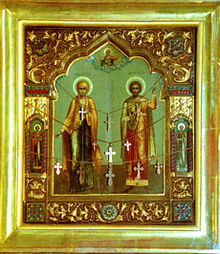- Adrian and Natalia of Nicomedia
-
Adrian and Natalia of Nicomedia 
Saint Adrian and his wife, Saint NataliaMartyrs Died 4 March 306
Nicomedia[1]Honored in Roman Catholic Church
Eastern Orthodox ChurchMajor shrine Argyropolis near Constantinople;
Geraardsbergen, Belgium;[1]
Church of St Adriano al Foro, Rome[2]Feast 8 September (Roman calendar)
26 August (Greek calendar)[1]
1 December[3]Attributes depicted armed, with an anvil in his hands or at his feet Patronage plague, epilepsy, arms dealers, butchers, guards, soldiers Saint Adrian (also known as Hadrian) or Adrian of Nicomedia was a Herculian Guard of the Roman Emperor Galerius Maximian. After becoming a convert to Christianity with his wife Natalia, Adrian was martyred at Nicomedia on March 4, 306.[2]
Contents
Martyrdom
It is said that while presiding over the torture of a band of Christians, he asked them what reward they expected to receive from God. They replied, "Eye hath not seen, nor ear heard, neither have entered into the heart of man, the things which God hath prepared for them that love him" (1 Corinthians 2:9). He was so amazed at their courage that he publicly confessed his faith, though he had not himself yet been baptised. He was then immediately imprisoned himself. He was forbidden visitors, but accounts state that his wife Natalia came to visit him dressed as a boy to ask for his prayers when he entered Heaven.[4] Later, Christians took Adrian's body and buried him on the outskirts of Byzantium, at Argyropolis.
Natalia went to live there herself, taking one of Adrian's hands which she had recovered. When she herself died, she was buried with the martyrs.
Historicity
The accuracy of the recorded story has been questioned. Some sources[who?] state that there were actually two Adrians martyred at Nicomedia, one under Diocletian, and one under Licinius.
Feast day and patronage
In the Eastern Orthodox Church, Saint Hadrian shares a feast day with his wife on September 8; he also has feast days alone on March 4 and August 26. In the Roman Catholic Church he is venerated alone, without his wife, on 8 September.[5]
Saint Hadrian is protector against the plague, and patron of old soldiers, arms dealers, butchers and communications phenomena. He was the chief military saint of Northern Europe for many ages, second only to St. George, and is much revered in Flanders, Germany and the north of France. He is usually represented armed, with an anvil in his hands or at his feet.
References
- ^ a b c Jones, Terry. "Adrian of Nicomedia". Patron Saints Index. http://www.catholic-forum.com/saints/sainta43.htm. Retrieved 2007-12-29.
- ^ a b Kirsch, J.P. (1910). "Hadrian". The Catholic Encyclopedia. 7. Robert Appleton Company. http://www.newadvent.org/cathen/07105a.htm. Retrieved 2007-12-29.
- ^ Holweck, F. G. (1924). A Biographical Dictionary of the Saints. St. Louis: B. Herder Book Co..
- ^ "St. Adrian". Catholic Online Saints & Angels. http://www.catholic.org/saints/saint.php?saint_id=253. Retrieved 2008-03-04.
- ^ Martyrologium Romanum (Libreria Editrice Vaticana, 2001 ISBN 88-209-7210-7)
- Attwater, Donald and Catherine Rachel John (1993). The Penguin Dictionary of Saints (3 ed.). New York: Penguin Books. ISBN 0-14-051312-4.
Categories:- 3rd-century births
- 306 deaths
- Members and leaders of the Praetorian guard
- Christian martyrs of the Roman era
- Saints from Anatolia
- Anatolian Roman Catholic saints
- Female saints
- Married couples
- Converts to Christianity
- 4th-century Christian martyr saints
- 4th-century Romans
Wikimedia Foundation. 2010.


